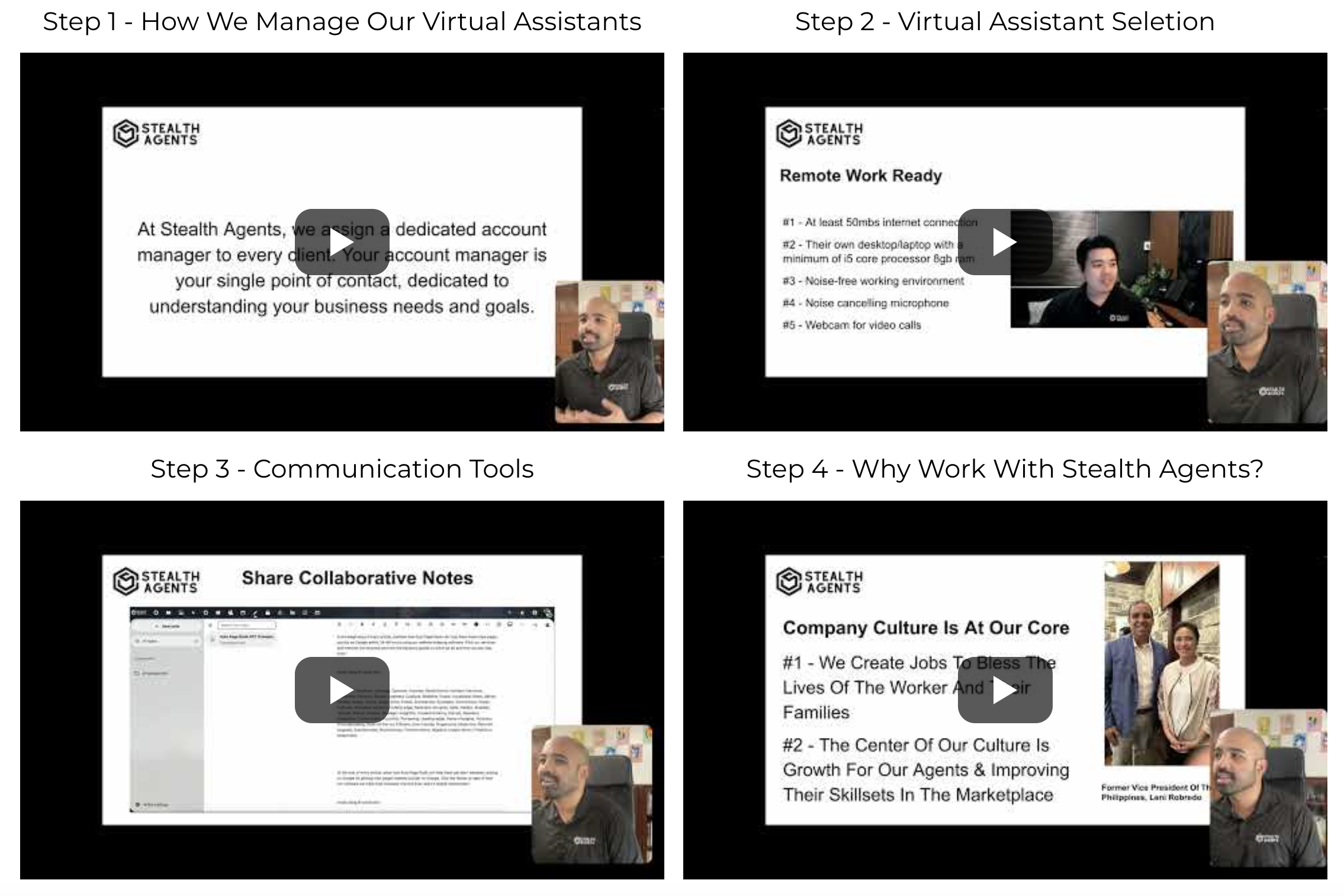Navigating the digital workspace can be challenging, especially when choosing between tools like Slack vs Wrike.
Slack excels in team communication, offering a streamlined real-time messaging and collaboration platform ideal for managing virtual assistant.
On the other hand, Wrike provides robust project management features, making it a top choice for overseeing complex projects and tasks, with insights into virtual assistant pricing for resource allocation.
While Slack facilitates seamless interactions, Wrike empowers teams with detailed project timelines and reporting capabilities.
Analyzing these differences is crucial for businesses aiming to optimize workflow and enhance productivity.
Stealth Agents have meticulously created this resource, drawing on industry expertise to help you make informed decisions.
Whether you’re seeking practical communication tools or comprehensive project management solutions, this guide is a valuable asset.
What is Slack?
Slack is a robust communication platform to streamline team collaboration and enhance productivity.
It seamlessly integrates messaging, file sharing, and various productivity tools within a single interface.
Slack’s intuitive design and customizable notifications ensure users stay connected without being overwhelmed.
The platform’s flexibility accommodates both large enterprises and small teams, adapting to diverse workflows.
With its emphasis on simplicity and efficiency, Slack positions itself as an indispensable tool for modern workplaces.
Key Features:
- Real-time Messaging: Communicate instantly with team members through direct messages or group channels, reducing reliance on emails and improving response times.
- Integrations: Seamlessly connect with over 2,000 apps and services, including Google Drive, Trello, and Zoom, to centralize workflow operations.
- File Sharing: Easily share and access files within conversations, ensuring all team members have the information they need at their fingertips.
- Searchable History: Slack’s powerful search functionality makes it easy to access past messages and files, helping teams find crucial information quickly.
- Customizable Notifications: Tailor notification settings to prioritize essential messages, minimize distractions, and maintain focus on critical tasks.
Pros:
- Enhanced Collaboration: Slack promotes efficient teamwork by providing a centralized communication and file-sharing platform, which fosters collaboration and idea exchange.
- User-Friendly Interface: Its intuitive design makes it easy for new users to navigate and adopt, reducing the learning curve and improving user engagement.
- Versatile Integrations: Slack offers a wide range of integrations, allowing teams to consolidate their tools, streamline processes, and enhance productivity.
- Mobile Accessibility: Available on mobile devices, Slack ensures team members can stay connected and responsive, even on the go.
- Security Features: Robust security controls, including two-factor authentication, safeguard sensitive business communications and provide peace of mind.
Cons:
- Notification Overload: Without careful management, users may experience disruption due to excessive notifications, which can hinder productivity.
- Learning Curve for Advanced Features: While essential functions are user-friendly, mastering Slack’s advanced features may require additional time and training.
- Cost for Premium Features: Some more advanced features are available only in paid plans, which could be a consideration for budget-conscious teams.
- Dependence on Internet Connectivity: Slack requires a stable Internet connection, which may pose challenges for teams in areas with unreliable network access.
- Potential for Distraction: The platform’s real-time nature can sometimes lead to off-topic discussions, diverting attention from priority tasks.
What is Wrike?
Wrike is a feature-rich platform for project management and collaboration that is intended to improve efficiency and simplify processes for teams of any size.
With a user-friendly interface and strong instruments, it helps businesses manage tasks, projects, and resources efficiently.
Wrike provides a centralized hub for all project-related activities by integrating seamlessly with other applications.
Its customizable dashboards and real-time reporting offer valuable insights into project progress and team performance.
Wrike empowers organizations to stay agile and responsive, making sure that projects are delivered on time and within budget.
Key Features
- Task Management: Wrike simplifies task assignment and tracking, enabling teams to prioritize work effectively and meet deadlines consistently.
- Collaboration Tools: Integrated communication tools facilitate seamless interaction among team members, reducing the need for external communication platforms.
- Customizable Dashboards: Users can tailor dashboards to their preferences, providing quick access to essential project data and metrics.
- Real-Time Reporting: Detailed reports can be generated instantly, offering insights into project timelines, resource allocation, and overall performance.
- Integration Capabilities: Wrike connects with various third-party apps, allowing for a cohesive workflow across different tools and platforms.
Pros
- User-Friendly Interface: This platform is designed to be accessible to users of varying technical expertise. This intuitive layout ensures teams can quickly adopt the system without extensive training.
- Scalability: Wrike is suitable for both small teams and large enterprises, offering flexible solutions that grow with your business needs. Able to handle both simple and complex projects makes it versatile.
- Enhanced Productivity: By streamlining processes and centralizing information, Wrike helps teams to work more efficiently. This leads to improved output and faster project completion times.
- Robust Security: Wrike uses enterprise-grade security measures to secure sensitive information, giving businesses peace of mind that their data is secure.
- Comprehensive Support: Wrike provides extensive resources and support options, including webinars, tutorials, and customer service, to assist users in maximizing the platform’s potential.
Cons
- Cost: The pricing model may be prohibitive for smaller organizations, especially those with limited budgets. It offers a free tier, advanced features require a paid subscription.
- Complexity for New Users: Despite its user-friendly design, the breadth of features can overwhelm newcomers. The initial setup and learning curve require additional time and resources.
- Limited Offline Access: Wrike is primarily cloud-based, meaning access to its features offline is restricted. This can be a limitation for teams needing to work without internet connectivity.
- Customization Limitations: While it offers customizable dashboards, some users may find the customization options for specific features lacking. This could limit personalization for particular business needs.
- Notification Overload: Users may experience an inundation of notifications, which can be distracting. Managing notification settings is essential to ensure important alerts are prioritized.
Slack vs Wrike: Detailed Features Comparison
1. Communication Tools
Communication is crucial in the Slack vs Wrike discussion, especially when considering effective communication in different situations.
Slack shines with its real-time messaging features, including channels, direct messages, and video calls, making it an ideal hub for team conversations.
On the other hand, Wrike, as a project management tool, facilitates communication through task comments and updates, allowing discussions to be contextualized within projects.
Slack supports large-scale team interactions seamlessly, while Wrike’s communication capabilities are more tailored to specific projects.
For those like a Filipino virtual communicator seeking a platform centered on communication, Slack offers a more comprehensive set of features compared to Wrike.
2. Collaboration Features
In the realm of best productivity apps for remote collaboration, both Slack vs Wrike present distinct benefits.
Slack enhances team interaction across various functions by integrating with numerous apps and bots.
On the other hand, Wrike centralizes tasks, deadlines, and project updates, keeping team members aligned in their workflows.
Wrike’s collaboration tools excel in project management, enabling teams to work collectively on tasks and track progress seamlessly.
While Slack encourages open communication, Wrike is more adept at structured project collaboration.
3. Integration Capabilities
The integration capabilities of Slack vs Wrike highlight the versatility of both platforms.
Slack connects with various third-party applications, from project management tools to social media platforms, creating a unified communication ecosystem.
Wrike also offers extensive integrations, particularly with productivity tools, to streamline project management processes.
Both platforms excel in enhancing their core functionalities through integrations, but Slack’s integration options are more diverse, catering to a broader range of business needs.
This makes Slack a more flexible choice for businesses looking to expand their toolset.
4. User Interface and Experience
The user interface comparison between Slack vs Wrike reveals distinct differences.
Slack’s interface is sleek and intuitive, designed for quick navigation and ease of use, making it accessible for users of all levels.
Wrike offers a more complex interface with customizable dashboards and detailed project views, which can overwhelm new users but provide comprehensive project insights.
While Slack prioritizes simplicity and user-friendliness, Wrike’s interface has features tailored for in-depth project management.
The choice depends on whether simplicity or feature-rich environments are preferred.
5. Pricing Structure
The pricing structure in Slack vs Wrike is a crucial consideration for businesses.
Slack offers a free version with limitations on searchable messages and integrations, with paid plans unlocking more features.
Wrike also provides a free tier, but advanced features and extensive integrations require a subscription.
While Slack’s pricing is more straightforward, Wrike’s cost can add up for businesses needing comprehensive project management capabilities.
Both platforms offer scalable pricing to accommodate different business sizes, but the decision hinges on whether communication or project management is the primary focus.
How Stealth Agents Choose Slack vs Wrike?
When deciding between Slack vs Wrike, stealth agents weigh several critical factors to make an informed choice.
First, they would assess their communication needs, considering Slack’s robust real-time messaging and channel organization, which might be ideal for dynamic team interactions.
However, if their focus leans toward structured project management, Wrike’s centralized task management and project updates would be more beneficial.
Integration capabilities also play a crucial role, as Slack offers extensive connectivity with various third-party applications.
In contrast, Wrike’s integrations are more tailored towards enhancing productivity within project management.
The user experience is another consideration, with Slack’s intuitive interface offering ease of use, while Wrike provides detailed project views and customizable dashboards that may require a steeper learning curve.
Cost-effectiveness would also be evaluated, as both platforms offer free tiers but require subscriptions for advanced features.
Ultimately, the decision in the Slack vs Wrike debate would hinge on whether Stealth Agents prioritize open communication or best project management software functionalities in their operations.
Conclusion
In the Slack vs Wrike comparison, the choice ultimately depends on the specific needs of a team and their focus on productivity vs hours worked.
Slack facilitates quick communication, allowing teams to save time on lengthy emails and meetings, which can boost productivity without extending work hours.
Conversely, Wrike offers a structured approach to project management, helping teams maintain focus and efficiently track progress, which can lead to higher productivity within regular work hours.
For teams prioritizing seamless communication and quick interactions, Slack is an ideal choice.
However, if managing complex projects and aligning tasks is crucial, Wrike might be the better option.
Both platforms aim to enhance productivity, but the decision should align with whether communication flow or project structure is more important to your team’s success.












